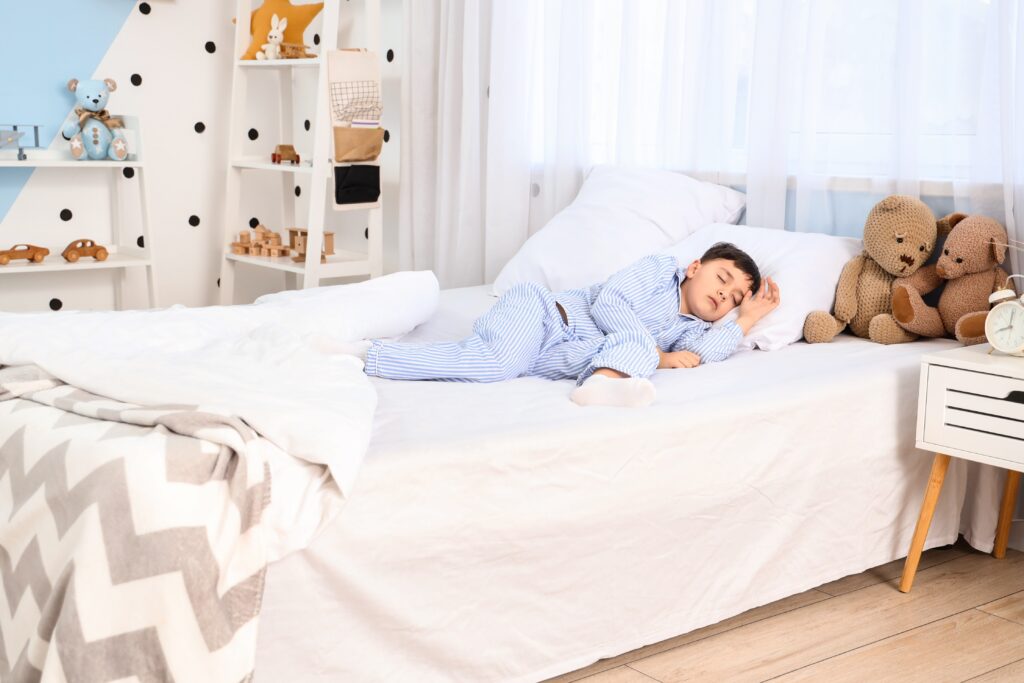
Creating an ideal sleep environment for your child is essential for their overall well-being and development. The right surroundings can significantly impact their ability to fall asleep and stay asleep throughout the night. In this blog post, we’ll explore various factors that contribute to a peaceful sleeping atmosphere, from room design to bedtime routines that promote relaxation.
The location of your child’s bedroom plays a crucial role in their sleep quality. Ideally, their room should be situated in a quiet part of the house, away from noise distractions like traffic or loud family activities. If possible, choose a space that doesn’t receive direct sunlight in the morning, helping to prevent early wake-ups. Consider adding soundproofing features such as heavy curtains or even sound machines that can drown out unwanted noises.
Temperature control is vital for sleep comfort. Most experts suggest keeping a child’s bedroom between 68°F and 72°F (20°C to 22°C). A cooler room often promotes better sleep, as it mimics the natural drop in body temperature that occurs during slumber. Use fans, air conditioning, or even heaters to adjust the temperature, and dress your child in breathable fabrics to help regulate their body heat.
The ambiance of a room can have profound effects on a child’s ability to unwind. Soft lighting is crucial; consider using dimmable lights or bedside lamps that allow for a gentle glow. Blue light from screens can interfere with the body’s natural sleep cycle, so make it a rule to limit screen time at least an hour before bedtime. Instead, opt for calming activities such as reading or storytelling to prepare your child for sleep.
Investing in a good quality bed and bedding can significantly affect your child’s sleep quality. Choose a comfortable mattress that supports your child’s unique sleep posture. Additionally, high-quality sheets made from natural materials like cotton or bamboo can provide breathability and comfort. Be mindful of allergies—ensure that the bedding is hypoallergenic, especially if your child is sensitive to dust mites or other allergens.
Sleep accessories can enhance the sleeping experience. Sleep masks can block out light effectively, while white noise machines or soft lullabies can soothe children to sleep. Comfort items like a favorite stuffed animal or blanket can also provide a sense of security, making it easier for children to drift off. Be careful not to overcrowd the bed, though. Too many items can make the sleep space feel cluttered and less relaxing.
A consistent bedtime routine helps signal to your child that it’s time to wind down and prepare for sleep. Start with calming activities that can occur in the same sequence each night. This might include a warm bath, followed by reading a story together, and ending with some quiet time for snuggles. The predictability of a routine helps children feel secure and reduces anxiety, making falling asleep easier.
Physical activity throughout the day can promote restful sleep at night. Encourage your child to engage in outdoor play, sports, or other forms of physical exercise. Only beware of timing; vigorous activity just before bedtime may leave them too energized to sleep. Aim for active play to take place earlier in the day, with quieter indoor activities as night falls.
Diet plays a vital role in sleep quality. Be mindful of your child’s intake of caffeine and sugary foods, especially later in the day. Caffeine can be found in soda, chocolate, and some snacks, and should be avoided in the afternoons. Instead, offer healthy snacks like fruit or yogurt in the evening that can help settle their stomachs without impacting their ability to fall asleep.
Many children experience fears or nightmares that can disrupt their sleep. It’s essential to acknowledge these feelings and offer reassurance. You might create a “worry box” where your child can write or draw their fears, which can help them release these anxieties. Additionally, discussing their dreams in the morning can also provide a safe space for them to express their feelings.
Finally, it’s important to foster an environment where sleep is valued. Talk to your child about the benefits of sleep for their mood, growth, and ability to learn. By cultivating a positive attitude towards sleep, you can help them develop healthy sleep habits that will last a lifetime. Make bedtime a cherished time, free from distractions, where they feel loved and secure.
Creating the perfect sleep environment for your child involves considering various factors, from the room’s location and temperature to the roles of routines and dietary choices. By putting effort into these aspects, you can help your child achieve restful and restorative sleep, which is fundamental for their growth and happiness. Remember that every child is unique; it might take some trial and error to discover what works best for your family. With patience and consistency, you’ll be well on your way to sweet dreams for your little ones.


